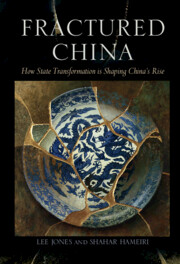Book contents
- Fractured China
- Fractured China
- Copyright page
- Dedication
- Contents
- Figures
- Maps
- Tables
- Acknowledgements
- Abbreviations
- Introduction
- 1 State Transformation and Chinese Foreign Policy
- 2 State Transformation and the South China Sea
- 3 Chinese Non-Traditional Security Governance in the Greater Mekong Subregion
- 4 China’s International Development Financing
- Conclusion
- References
- Index
2 - State Transformation and the South China Sea
Published online by Cambridge University Press: 21 October 2021
- Fractured China
- Fractured China
- Copyright page
- Dedication
- Contents
- Figures
- Maps
- Tables
- Acknowledgements
- Abbreviations
- Introduction
- 1 State Transformation and Chinese Foreign Policy
- 2 State Transformation and the South China Sea
- 3 Chinese Non-Traditional Security Governance in the Greater Mekong Subregion
- 4 China’s International Development Financing
- Conclusion
- References
- Index
Summary
This chapter presents the book’s first case study: the South China Sea (SCS). Typically, the SCS is seen as a geopolitical struggle for sovereignty and territory, prompting military tensions and power balancing, and as a major security flashpoint that could spark World War III. This chapter shows that Chinese conduct in the SCS is shaped less by a detailed strategy determined in Beijing and more by struggles for power and resources within the transformed Chinese party-state. Reflecting the model described in Chapter One, Chinese conduct is only loosely guided by the poorly-defined nine-dash line and an injunction to balance the maintenance of stability and the protection of maritime rights, which are often contradictory objectives. This has created wide latitude for maritime actors – including the navy, coastguard agencies, the national oil companies and the Hainan provincial government and associated fishing interests – to promote their sectional interests, with often very negative consequences for China’s wider diplomatic objectives. Xi Jinping’s efforts to rein in competing actors has only partially succeeded. Although China’s position in the SCS has overall strengthened, it has done so in a rather unplanned manner and consequently at considerable cost.
Keywords
- Type
- Chapter
- Information
- Fractured ChinaHow State Transformation Is Shaping China's Rise, pp. 72 - 120Publisher: Cambridge University PressPrint publication year: 2021

